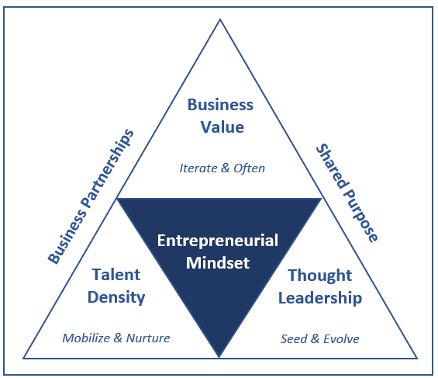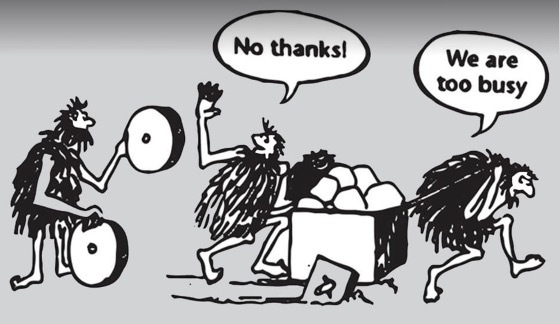
We have explored the disruption taking place in the healthcare industry, how the digitization of the consumer experience and analytics-AI are powering this disruption, the forces for and against change, and the operating model leveraged by leaders in other industries to thrive in this ecosystem of uncertainty and rapid evolution — embracing start-up practices to accelerate their data innovation journey.
With all its promise and success, this operating model is no guarantee. No doubt you have seen or experienced failed attempts. The journey starts with the same energy, excitement and commitment as successful ones. However, twelve months into a new way of working, homeostasis returns the organization to its baseline, with little or no change in productivity, innovation or employee satisfaction. Entropy sets in.
We keep trying to fix the problem with new approaches, or sunk cost fallacy settles in and we double down on an approach that is not working. Either way, no progress is made, people get frustrated and cynical, money is wasted, and opportunity is lost. The issue isn’t the operating model. The key is the operating philosophy – it helps to think like an entrepreneur.
As illustrated by the photo below, this operating philosophy embraces the idea that the ultimate measure of success is demonstrated business value delivered incrementally and often. To achieve this success, there are two cornerstones: talent density and thought leadership.

The quantity and quality of value delivered are directly related to the depth and breadth of the talent in the analytics community, and their ability to build relationships and partnerships across the business. This is Talent Density. Reed Hastings and Erin Meyer explain the importance of talent density and how to nurture it in their book No Rules Rules: Netflix and the Culture of Reinvention.
Thought leadership is the vision of how the community will create value. There is nothing more powerful than organizing people around an idea. There is a belief that the reason sapiens survived when other human species didn’t was their ability to organize large groups of people around an idea. Think of all the movements that have formed this way, good and bad. They started with an idea that galvanized a community.
Marketing also taps into this characteristic of sapiens to engender brand loyalty. Similarly, branding is essential to building a healthy and unified analytics community. Yuval Noah Harrari covers what we know about this aspect of being human in his book Sapiens: A Brief History of HumandKind, and Nir Eyal explains how to tap into this trait in his book Hooked.
Business value, talent density and thought leadership are the components of the engine that powers the operating model and the mindset is the fuel. How well the engine runs will depend on the quality of the fuel. Let’s take a deeper look at how our mindset can get in our way, and how the entrepreneurial mindset is the jet fuel to the engine.
The image below exemplifies how our mindset gets in the way. We’ve been on both sides — trying to help people use the wheel to improve their lives and being too busy to accept (or even see) the offer to help. To succeed, we need to nurture an analytics community that promotes a mindset of continuous change.

Here are other examples of how our mindset gets in the way:
- “Why it can’t be done” – We have heard this comment countless times. Nothing is more crushing to creativity and innovation. Imagine the power of changing the mindset to “How do we make it happen.”
- “Go big or go home” – This mindset rarely translates to success. We spend a lot of time and money planning and aligning. Often these projects are cut. If approved, we spend many more months implementing the solution — only to find that the needs have changed in response to a rapidly evolving business landscape. This mindset also reduces innovation because many small ideas never see the light of day. Imagine the power of changing the mindset to “Think big, act small.” Try many small things, double-down on those that show promise, and quickly stop those that don’t and carry forward lessons learned.
- “We don’t have a mandate” – This mindset is a safe place. There is no consequence for inaction, right? True, one rarely gets in trouble or fired for inaction. However, in the back of our mind, we know there are consequences for physicians, nurses, administrators and patients, so we have a moral obligation to act. So, we have a moral obligation to act. There is always a way to get started and evolve your analytics ecosystem if you are willing to be creative, work hard and take risks. Imagine the power of the mindset “How do we partner creatively to get started.” Small successes will grow into increasingly larger successes, along with sponsorship and funding.
This list could go on and on. However, each example illustrates two ways of thinking. We have all experienced the first way of thinking that is epidemic in traditional organizations like healthcare. If you are someone who wants to innovate with data to help people live healthier lives, this way of thinking is soul-crushing. The other way of thinking is seeing the obstacle as the way to make the impossible possible and helping people along the way. This is thinking like an entrepreneur. Let’s dig into this mindset in more detail.
Entrepreneurial Mindset
Some people are born entrepreneurs, others develop these traits over time. There is no one single recipe or process for becoming a successful entrepreneur. But every entrepreneur shares a core set of attributes: a strong belief and a commitment to what they want to achieve, the tenacity, perseverance and grit to make it happen, and the ability to inspire others to join the journey.
There are many excellent books and articles on entrepreneurialism, and we include a list of our favorites below. We aren’t going to repeat or try to recreate these. We want to share our experiences of developing an entrepreneurial mindset within a traditional healthcare setting with the end-goal of accelerating your data innovation journey.
Brené Brown, a researcher and storyteller, often references a quote from Theodore Roosevelt’s 1910 “Man in the Arena” speech as her inspiration. The quote goes: “It is not the critic who counts; not the man who points out how the strong man stumbles, or where the doer of deeds could have done them better. The credit belongs to the man who is actually in the arena, whose face is marred by dust and sweat and blood; who strives valiantly…who at the best knows in the end the triumph of high achievement, and who at the worst, if he fails, at least fails while daring greatly.”
Some believe that the only way to bring entrepreneurialism to healthcare is to start a new company and operate from the outside. We believe healthcare transformation can only occur when it happens from the outside and the inside, and we have experienced the adoption of the entrepreneurial mindset in provider organizations with great success. However, to build on Teddy’s words, adopting an entrepreneurial mindset requires daring greatly. Let’s take a closer look at what an entrepreneurial mindset values.
Entrepreneural Mindset Values Strong Vision, Belief and Commitment
Traditional healthcare organizations have a hierarchical and established way of doing things. This approach benefits them in a number of ways. But unless you’re already a trusted leader or a tenured, respected provider, opportunities to change the status quo are few and far between. And, should you desire to do things differently, you’ll have to navigate a number of personality types, and risk people feeling uncomfortable (like you’re going around them or pushing them out of their comfort zone) before you can call anything a success. Unless it is a sanctioned trial or research project (with an established process to do new things), it’s easy to see why more people don’t try this.
In Simon Sinek’s book Start with Why: How Great Leaders Inspire Everyone to Take Action, he explains that Why is the most important message an organization or individual can communicate to inspire action in others. This is because the passion behind the Why resonates with the listener’s limbic brain; the part of our anatomy that processes feelings like decision-making, loyalty and trust. Sinek says, “People don’t buy what you do, they buy why you do it.”
Clearly articulating why you believe in something is the foundation for creating excitement and bringing people along on the data innovation journey. It is equally important to enrich this belief as you receive feedback from others. Great achievement always starts with a good idea and the ability to inspire others to achieve something greater. Let’s take a closer look.
Entrepreneurial Mindset Values Ability To Inspire And Bring Others Along
In 2008, the comedian George Carlin, coined the term vuja dé. Harvard Business Review wrote an article about how Carlin’s spin on the term déjà vu has “become a battle cry of sorts for innovators who aspire to make a big change by identifying opportunities that others don’t see.” Fast Company published an article in 2011 saying their term vu déjà was all about “looking at a familiar situation as if you’ve never seen it before.”
The concept of reinterpreting déjà vu to mean “looking at a situation with new eyes” is a powerful one. Vuja dé can be used in multiple ways. A new perspective will help you more clearly define your Why. Another view can reveal the perceived benefits and challenges unique to each person. To be a successful entrepreneur in a traditional healthcare organization, you must invest a good amount of your time and energy to bring others along on your journey. And because we’re all different, you’ll need to engage other people in different ways. HR Zones’ article titled “The Eight Personalities Involved in Change Management Programmes,” does an excellent job of summarizing each personality type and how each can aid or block you.
The more you communicate your vision – and help people understand how this work can benefit them – the easier it will be to build momentum and achieve success. Identify and pay extra attention to the individuals with social clout. These may be titled leaders or recognized knowledge experts at lower levels in the organization. At a minimum, you’ll want to identify your champions and ambassadors – those who will help you move things forward; and your saboteurs and thieves – those who actively work against you. It is important to understand the needs of these individuals and invest the time and energy early on to engage them in a way that is relevant to them and ultimately enables a clear path forward.
This strategy typically brings even the most stubborn objectors on board. You may not change everyone’s mind but the vast majority will support you. Bringing the right people along will also help you traverse the highs and lows of the entrepreneurial journey, and help you persevere.
The Entrepreneurial Mindset Values Tenacity, Perseverance, and Grit
Gary Keller’s and Jay Papsan’s book titled The ONE Thing: The Surprisingly Simple Truth Behind Extraordinary Results focuses on identifying your one thing such that by doing it everything else will be easier or unnecessary. The quote on page 117 is our favorite: "Until my ONE Thing is done – everything everything (sic) else is a distraction."
The entrepreneurial spirit is the ONE thing that will make your data acceleration and transformation journey successful. You can leverage different operating models, goal-setting and tracking methodologies, and technologies, but none alone will drive the success you envision.
Without adopting an entrepreneurial spirit, you’ll risk doing the same thing again. Yes, work will get done, but it will be a slow, safe way of moving forward with little to no momentum to advance the changes needed to be transformative or innovative.
So, how does one become a successful entrepreneur? You have a clear belief/vision and are committed to pursuing it. You have the tenacity, perseverance and grit to see it through. But you cannot do this all by yourself. In an organization where the status quo is comfortable, it’s quite likely that some of the people you will need help from may not be as enthusiastic as you are. To be successful you need to lead from a position of influence and not authority.
The Entrepreneurial Mindset Values Intrinsic Motivation
Much has been studied and written about the power of intrinsic motivation over the past fifty years. If the work is heuristic versus algorithmic, intrinsic motivation creates an environment where employees are more productive, innovative, and enriched. These ideas were introduced in the early 70s by Edward Deci and Richard Ryan, and popularized by Daniel Pink in his book Drive.
Even though more and more of our work environment depends on knowledge workers, many leaders continue to motivate extrinsically — carrot and stick. The leader directs and the employee delivers. If we do well, we are rewarded. If not, we are punished. The work environment has changed to be much more heuristic. A new way of leading and motivating is needed.
In an intrinsically motivated environment, decision-making happens where the work is done. Frontline employees create goals and tasks based on strategic guidance, and the role of leadership is to provide context, advocacy and support with minimal direction. Intrinsic motivation creates an ecosystem that fosters self-motivation and drive. This has been demonstrated across multiple industries and multiple ways ranging from start-ups to established organizations. L. David Marquet’s book Turn This Ship Around outlines how these practices are applied on a nuclear submarine (where lives are on the line) with great success.
There is no better way of bringing people along than encouraging engagement and contribution from team members and stakeholders. This doesn’t mean that everything has to be acted upon, nor does it mean that everyone has to agree with the direction. With extrinsic motivation, the leader dictates. You get what you get. The primary benefit of intrinsic motivation comes when the leader encourages and incorporates diverse perspectives. You get something better.
The Rest of the Secret Sauce
Amazon.com has over 50,000 books on entrepreneurism. Another 9,000-plus books on how to successfully drive change in an organization. Clearly, there’s strong interest in these topics and the elements inherent to each.
There are many other qualities attributed to successful entrepreneurs. We’ve covered the ones we believe form a solid foundation from which to expand upon: Passion, commitment, tenacity, perseverance, grit, and the ability to inspire others to join the journey using intrinsic motivation. Encapsulated in these are persuasion, diversity, curiosity, leadership, bias for action, being empathic, having integrity, and personal accountability.
Other attributes like being a strategic thinker, being enthusiastic, having emotional intelligence, having a desire to improve oneself, incorporating the community, being bold, and leveraging your connections and network add dimension and depth. We could write a blog about each, but without the foundational attributes we’ve covered in this blog, there is no clear direction.
In Closing
In our next blog we’ll focus on how to get started on your data innovation journey. Every journey needs a MAP and we’ll step you through the process of developing your MAP. MAP represents a Maturity Accelerator Plan (in an earlier blog we referenced this as the Action Plan). The MAP will help you navigate your organization’s terrain as you progress through a successful transformation journey.
Additional Recommended Reading
- Grit: The Power of Passion and Perseverance
- Loonshots: How to Nurture the Crazy Ideas That Win Wars, Cure Diseases, and Transform Industries
- The Founder's Dilemmas: Anticipating and Avoiding the Pitfalls That Can Sink a Startup
- The Hard Thing About Hard Things: Building a Business When There Are No Easy Answers
- The Innovator's Prescription: A Disruptive Solution for Health Care
- The Lean Startup How Today's Entrepreneurs Use Continuous Innovation to Create Radically Successful Businesses
- The Patient Will See You Now: The Future of Medicine is in Your Hands